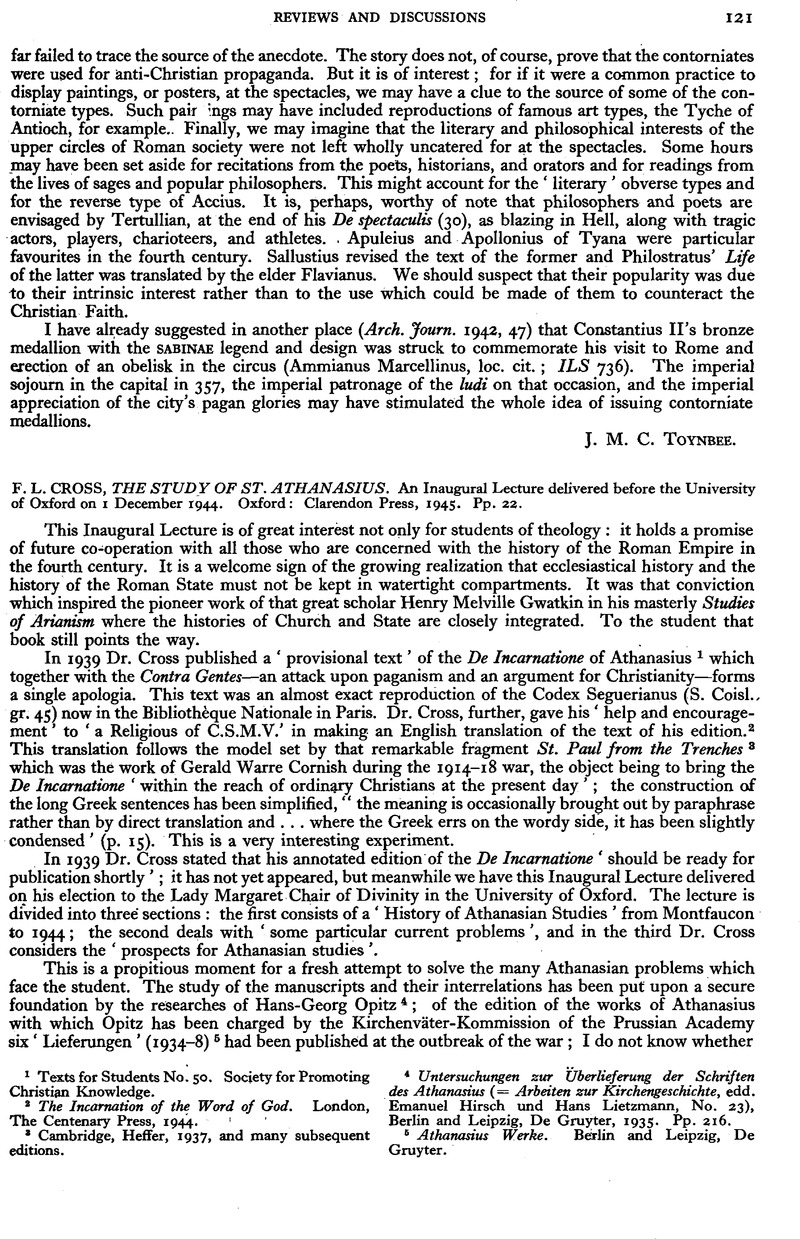No CrossRef data available.
Published online by Cambridge University Press: 24 September 2012

1 Texts for Students No. 50. Society for Promoting Christian Knowledge.
2 The Incarnation of the Word of God. London, The Centenary Press, 1944Google Scholar.
3 Cambridge, Heffer, 1937, and many subsequent editions.
4 Untersuchungen zur Überlieferung der Schriften des Athanasius (= Arbeiten zur Kirchengeschichte, edd Emanuel Hirsch und Hans Lietzmann, No. 23), Berlin and Leipzig, De Gruyter, 1935. Pp. 216.
6 Athanasius Werke. Berlin and Leipzig, De Gruyter.
6 Band 3, Teil i, Lieferungen 1 and 2.
7 This arrangement is based upon the view that there was a second session of the Council of Nicaea meeting late in 327; it is to be noted that Gustave Bardy still thinks that this hypothesis ‘se heurte à des véritables impossibilités; see his articles ‘La politique religieuse de Constantin après le concile de Nicée’ Revue des sciences religieuses 8 (1928), pp. 516–551CrossRefGoogle Scholar; ‘Sur la réiteration du concile de Nicée (327’), ibid. 23 (1933), pp. 430–450, and cf. his book Recherches sur Saint Lucien d'Antioche et son école, Paris, Beauchesne, 1936, pp. 311 ff.Google Scholar It is not easy to agree with Bardy's statement on p. 312: ‘Nous sommes d'ailleurs trop bien renseignés sur la suite de faits entre 325 et 330 pour pouvoir y placer un concile aussi important que l'aurait été une réiteration du concile de Nicée.’ We might have said the same, with greater excuse, of the Council of Antioch which, it is now generally agreed, met shortly before the Council of Nicaea. For the view that there was no second meeting of the Council see also Basile C. Stephanidès, Ἡ ἐκ δευτέρου τῷ 327 σύγκλησις τῆς ἐν Νικαίᾳ πρώτης οἰκουμενικῆς συνόδου (325), Ἐπετηρὶς Ἑταιρείας Βυзαντινῶν Σπουδῶν 6 (1929), 45–53, Cf. Heseler, P., Byzantinisch-neugriechische Jahrbb. 12 (1936), 343Google Scholar.
8 Nachrichten der Königl. Gesellschaft der Wissenschaften zu Göttingen, Philologisch-historische Klasse, 1904, Heft 4, 338–401, Heft 5, 518–547; 1905, Heft 2, 164–187, Heft 3, 257–299; 1908, Heft 3, 305–374; 1911, Heft 4, 367–426.
9 De Sancti Athanasii quae fertur Contra Gentes oratione. He argued that since ‘Athanasius’ had drawn upon the Theophaneia, and the Theophaneia of Eusebius depends upon the tenth book of the Church History, the apology must therefore be dated after A.D. 325.
10 Schwartz, E., ‘Der s.g. Sermo major de fide des Athanasius,’ Sitzungsberichte der Bayerischen Akad. d. Wiss. Philosophisch-philologische und historische Klasse, 1924, Abhandlung 6, 41–2Google Scholar.
11 Untersuchungen zur Überlieferung der Schriften des Athanasius 190–200. Opitz's argument is ‘just a mistake’, Cross, p. 13.
12 Gradenwitz, Qtto, ‘Staatsman, Kirchenvater und Interpolationen,’ Studi in onore di P. Bonfante 2, 21–38Google Scholar; pavia, 1920. For a similar analysis of the rule of St. Benedict, cf. Gradenwitz, ‘Textschichten in der Regel des H. Benedict’, Zeits. für Kirchengeschichte 50 (1931) 257–270Google Scholar.
13 Seiler, Rudolf, Athanasius, Apologia contra Arianos (ihre Entstehung und Datierung), Dissertation, Tübingen, 1932Google Scholar.
14 Lebon, J., ‘S. Athanase a-t-il employé l'expression ὁ κυριακὸς ἄνθρωπος?’ Revue d'hist. ecclés. 31 (1935), 307–329Google Scholar.
15 Cf. Professor Grégoire's remark, Byzantion 14 (1939), 319Google Scholar, ‘ma démonstration (que personne n'entreprendra de réfuter) ….’
16 Eusèbe n'est pas l'auteur de la “Vita Constantini“” dans sa forme actuelle et Constantin ne s'est pas “converti” en 312,' Byzantion 13 (1938), 561–583Google Scholar. For another estimate of the ‘Vita’ as providing the key to the understanding of the theology of Eusebius, cf. Opitz, H.-G., ‘Euseb von Caesarea als Theologe’, Zeits. f. die neutest. Wissenschaft 34 (1935), 1–19CrossRefGoogle Scholar.
17 For a discussion of one of these Athanasian ‘forgeries’ see Journal of Egyptian Archaeology 11 (1925), 61–5Google Scholar.
18 Bell, H. I., Jews and Christians in Egypt (British Museum, 1924) Pap. 1914, 53 ffGoogle Scholar.
19 Forster, E. M., Pharos and Pharillon, 3rd edn., London, Hogarth Press, 1926 49Google Scholar.
20 Cf. Bardy, G., Recherches stir Saint Lucien d'Antioche et son École. Paris, Beauchesne, 1936, 305–6Google Scholar.
21 Cf. Hagel, K. F., Kirche und Kaisertum in Lehre und Leben des Athanasius. Dissertation, Tübingen, 1933Google Scholar.
22 ‘Athanasius: A Chapter in Church History.’ Congregational Quarterly, 1925, No. 2, 158–176.